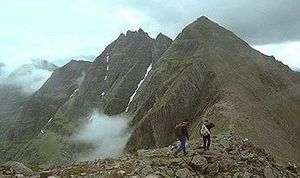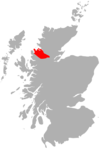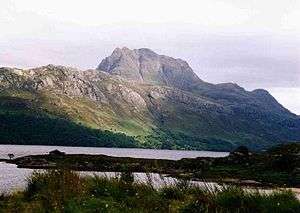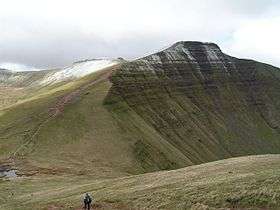An Teallach
| An Teallach | |
|---|---|
 Sgurr Fiona and the Corrag Bhuidhe pinnacles | |
| Highest point | |
| Elevation | 1,062 m (3,484 ft) [1] |
| Prominence | 756 m |
| Parent peak | Sgurr Mor |
| Listing | Munro (2), Marilyn (2) |
| Naming | |
| Translation | The Forge (Gaelic) |
| Pronunciation |
Scottish Gaelic: [əɲˈtʰʲalˠ̪əx] English approx: uhn challakh |
| Geography | |
| Location | Dundonnell and Fisherfield Forest, Scotland |
| OS grid | NH069843 |
| Topo map | OS Landranger 19 |
An Teallach is a mountain in Scotland. It lies to the southwest of Dundonnell and overlooks Little Loch Broom, in an area often nicknamed the "great wilderness". An Teallach means 'The Anvil' or 'The Forge' in Scottish Gaelic; although most scholars claim the latter is most correct as the mountain's name refers more to the colour of the terrain in certain lighting conditions, rather than shape.
The mountain is mostly made of Torridonian sandstone. Like the peaks around Torridon (for which the rock is named), An Teallach has terraced sides riven with steep gullies and a sharp rocky summit crest at Sgùrr Fiona. The steepest section, known as Corrag Bhuidhe, rises above Loch Toll an Lochain. Corrag Bhuidhe's most spectacular feature is an overhanging pinnacle known as Lord Berkeley's Seat.
Summits
An Teallach is a complex mountain massif, with ten distinct summits over 3,000 feet (914.4 m). From 1891 to 1981, only the highest of these, Bidean a' Ghlas Thuill, had the status of a Munro – a separate mountain over 3,000 feet. In 1981 the Scottish Mountaineering Club granted Munro status to Sgùrr Fiona, in recognition of its considerable topographic prominence (150 m) and distinct nature.[2] The complete list of Munros and Tops (subsidiary summits appearing on Munro's Tables) is now as follows:[3]
- Bidean a' Ghlas Thuill 1062 m (3484 ft)
- Glas Mheall Mòr 979 m (3212 ft)
- Glas Mheall Liath 960 m (3150 ft)
- Sgùrr Fiona 1060 m (3478 ft)
- Corrag Bhuidhe 1040 m (3412 ft)
- Lord Berkeley's Seat 1030 m (3379 ft)
- Sgurr Creag an Eich 1017 m (3337 ft)
- Stob Cadha Gobhlach 960 m (3150 ft)
- Sàil Liath 954 m (3130 ft)
- Corrag Bhuidhe Buttress 945 m (3100 ft) - deleted from Munro's Tables in 1997
Ascent routes
The simplest route of ascent is probably that from Dundonnell, which follows a good path over rising ground to reach the northern summit, Bidein a' Ghlas Thuill, a distance of about 6 km (3.7 mi). From here the second summit, Sgurr Fiona, lies about 1 km (0.62 mi) to the southwest.
An alternative northern route heads up from Corrie Hallie, which lies about 4 km (2.5 mi) south of Dundonnell. This route, some 5 km (3.1 mi) in length, climbs steeply up the headwall of the corrie of Glas Tholl to reach the main ridge just north of Bidein a' Ghlas Thuill.
Both of the above routes, however, miss out the central section, for which An Teallach is best known. A route reaching the summits from the south starts from near Corrie Hallie. It then follows a track (later a path) southwest for about 5 km (3.1 mi). Then it breaks off to the north, climbing the southern end of the ridge via a subsidiary summit known as Sàil Liath. Heading northwest towards the Corrag Bhuidhe buttresses a choice must be made. One may either scramble over them directly (including the crossing of Lord Berkley's Seat), or take the bypass path on the southwest side. This path is eroded in some places and should not be regarded as an easy option.
The winter traverse of the ridge is probably more demanding than that of Liathach or the Aonach Eagach, because of the comparative remoteness of the mountain. Some parties use the bothy at Shenavall as an overnight base.
Notes
- ↑ "walkhighlands Bidein a'Ghlas Thuill (An Teallach)". walkhighlands.co.uk. 2014. Retrieved 14 January 2014.
- ↑ Scottish Mountaineering Club - The New Munros Archived September 27, 2006, at the Wayback Machine.. Accessed 8 November 2006.
- ↑ Database of British and Irish Hills. Version 12, accessed 20 December 2011.
External links
- Computer-generated virtual panoramas An Teallach Index These can be compared with the photograph below.
- An Teallach on Walkhighlands

| Wikimedia Commons has media related to An Teallach. |
Coordinates: 57°48′24″N 5°15′06″W / 57.80653°N 5.25166°W



